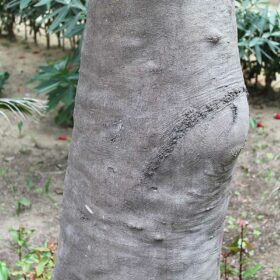IDENTIFYING THE LAURUS NOBILIS
Scientific name: Laurus nobilis L.
Italian common name: Alloro
Family: Lauraceae
Origin: Species native to the Mediterranean basin, from the coastal regions of southern Europe to North Africa and Asia and it is the species that gives the denomination to the phytoclimatic zone of the Lauretum.
Ambient: mesophilic species, lives in hot-humid climates. Its preferred habitat is that of fresh, sunny valleys, it prefers deep soils rich in nutrients. It tolerates the cold well but not the prolonged frosts. It also tolerates coastal and marine environments well.
Evergreen or deciduous: Evergreen
PLANT RECOGNITION OF LAURUS NOBILIS
Height: 6 – 10 m
Width (extension): 6 – 10 m
Habit: Shrub or small tree with dense, bushy and conical crown

Leaf: Simple, alternate, coriaceous, elliptical leaves, 6-10 cm long, with smooth wavy margin and acute apex, somewhat marked central vein; dark green-glossy above, paler below.
Flower: Small flowers, yellowish, with 4 petals, gathered in small axillary umbels;
Flowering: March – April
Fruit: The fruits are ovoid berries, 1-2 cm long, glossy black when ripe in September, containing a reddish ovate seed. The berries are edible and are indicated for digestive problems, cough,

cold or tiredness.
Trunk: smooth gray or blackish.
Perfume: intense
NEED
Maintenance: medium/low
Exposure to light: all exposures while preferring the sun.
Soil type: it adapts well to all soils but prefers deep, well drained and nutrient-rich ones (like all 😊).
Soil acidity: not relevant
Italian climatic area: Due to its typically Mediterranean distribution, its range extends over almost half of the national territory where it grows spontaneously in central-southern areas and along the coasts. In the northern regions it is found only where it is grown. It lives up to 800 meters of altitude.

Need for water: in winter it can be suspended. In the other seasons, water only if necessary due to lack of rain. Avoid standing water.
Diseases: cochineal, powdery mildew, sooty mold, peach blister, psylla, weevil. Diseases develop mainly in humid environments.
SPECIAL FEATURES:
The plant that symbolized victory is also good for the garden.
The root system is a taproot on which more superficial lateral roots develop over time.
Annotations
The ancient Greeks made wreaths with laurel sprigs

crown their winners. The leaves and the essence have the ability to ward off cockroaches.
Germicidal essences of the soil
Some essences, including Laurel, have shown the ability to sanitize the soil with a germicidal effect. Their effect is inconstant but real and is also scientifically proven.
For this reason Feng shui includes it among the plants to be placed in the garden – if possible – precisely because with its presence it is good for the well-being of other plants.
In the kitchen
Laurel is used a lot in cooking. In first courses such as in sauces, sauces, soups and soups, in second courses of meat, fish and in side dishes to make the flavor more decisive.
One or two leaves when cooking legumes facilitate their digestion.
Laurel oil can be prepared by macerating berries and leaves in 15% olive oil for 3 weeks.
If you are interested in Feng shui and want to learn more about it, you can start with the article “introduction to feng shui“
Now on horseback! Work awaits us! Our new wonderful outdoor space is about to be born!
GOOD WORK and…if you have any questions, write to info@ilmondodelgiardino.com
Image sources: thanks for the laurel flowers bur.regione.veneto.it; for the conical plant vivigreen.eu; for laurel fruit laurels-Tania Van den Berghen of Pixabay; for the trunk josecelestinomutis.cadiz.es.


